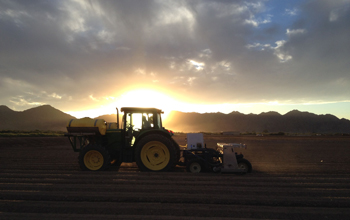Multimedia Gallery
"LettuceBot 2," operatIing in a field near Salinas, California
"LettuceBot 2," a lettuce thinning robot created by Blue River Technology, operates in a field near Salinas, California. The robot is collecting images that are processed to decide which plants to keep and which to destroy when thinning a field. LettuceBot 2, the next generation of Blue River's precise field robotics technology, processes data and performs real-time thinning four times faster than its predecessor, "LettuceBot 1."
More about this image
The food gap is becoming one of the world's biggest challenges. According to the United Nations, farmers must grow 70 percent more food by 2050 to feed the world's population. Founded in 2011, Blue River Technology is a small business in Mountain View, Calif., that's helping solve this challenge. The company merges robotics, computer vision and machine learning to change the way food is grown and to lift yields from every acre of farmland. Blue River's first technology, called LettuceBot 1, is a robot that intelligently and precisely thins lettuce fields.
Lee Redden, a National Science Foundation (NSF) principal investigator and a founder of Blue River, is leading a research team that's developing robots that use computer vision to recognize and identify the needs of plants and take appropriate action in real time, even in rugged agricultural conditions. For example, the robots can determine whether a crop needs thinning, then spray a killing agent with precision to rid excess plants and thin the field.
Funding from NSF's Small Business Innovation Research (SBIR) program (grant IIP 11-43463) played a key role in building a team and these machines. Blue River is now operating its precise field robotics as a commercial service and is beginning to develop new concepts that serve its vision: Advanced technology for better agriculture.
A video of the robots in action in the field can be viewed Here. To learn more about Blue River Technology, visit their website Here. (Date of Image: 2013)
Credit: ©Blue River Technology
See other images like this on your iPhone or iPad download NSF Science Zone on the Apple App Store.
Images and other media in the National Science Foundation Multimedia Gallery are available for use in print and electronic material by NSF employees, members of the media, university staff, teachers and the general public. All media in the gallery are intended for personal, educational and nonprofit/non-commercial use only.
Images credited to the National Science Foundation, a federal agency, are in the public domain. The images were created by employees of the United States Government as part of their official duties or prepared by contractors as "works for hire" for NSF. You may freely use NSF-credited images and, at your discretion, credit NSF with a "Courtesy: National Science Foundation" notation.
Additional information about general usage can be found in Conditions.
Also Available:
Download the high-resolution JPG version of the image. (585 KB)
Use your mouse to right-click (Mac users may need to Ctrl-click) the link above and choose the option that will save the file or target to your computer.

 All images in this series
All images in this series